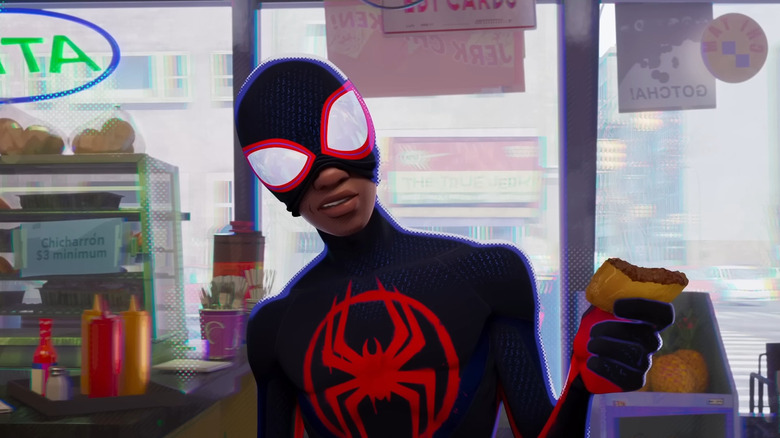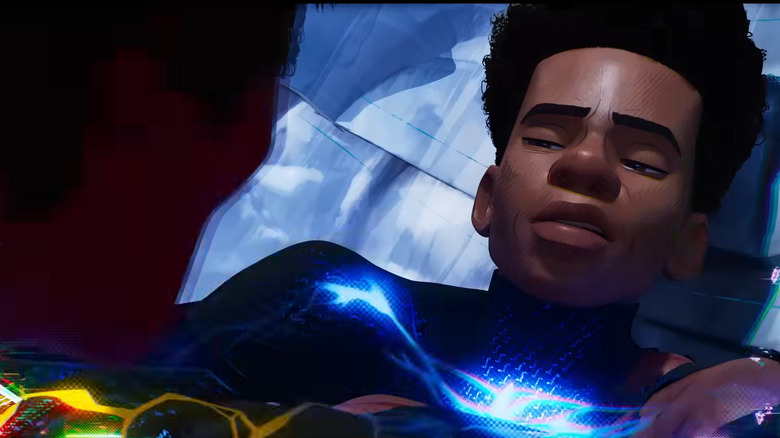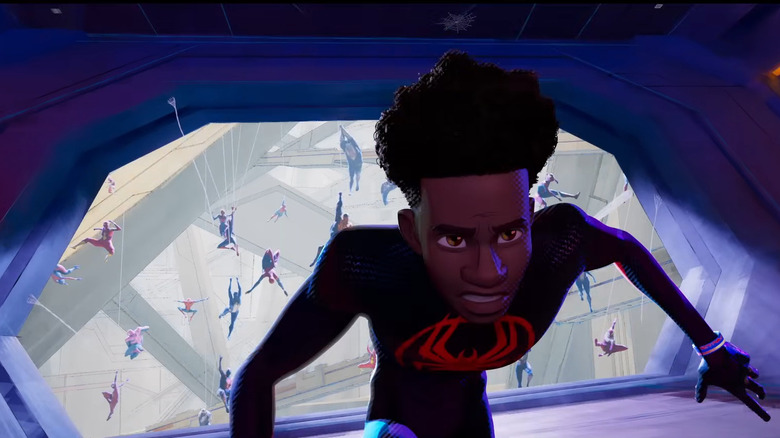Spider-Man: Across The Spider-Verse's Biggest Plot Twist Was Hiding In Plain Sight
The following article contains major spoilers for "Spider-Man: Across the Spider-Verse."
"Spider-Man: Across the Spider-Verse" took us back into the multiverse, starting with Gwen Stacy (Hailee Steinfeld) visiting Miles Morales (Shameik Moore) in the Brooklyn of Earth-1610. She then takes him to the Spider-Society, where Spider-Beings from all over the multiverse converge and help each other out.
Over the course of the film, Miles finds out that he wasn't ever supposed to be Spider-Man and, because of that, the universe of Earth-42 doesn't have one. Wha's more, he ends up having to evade the Spider-Beings who want to stop him from preventing a "canon event," as in something that must happen to create our web-slinging superheroes (specifically, one that will also kill his dad). As a result, Miles eventually makes his way to Earth-42, a place where his uncle Aaron (Mahershala Ali) is still alive, his dad is dead, and another version of Miles (Jharrel Jerome) has become the villainous Prowler instead of Spider-Man, leading to a crime-ridden society.
/Film's own Rafael Motamayor got a chance to speak with "Spider-Verse" production designer Patrick O'Keefe about Earth-42 and discuss this plot twist — more specifically, all the clues in the film leading up to it.
'You don't need to actually hide anything'
Referring to Earth-42 as "my baby," O'Keefe said he took special care to plant references to its existence throughout the film. "One thing [producer Phil Lord] and [producer Chris Miller] were very, very cautious of is we didn't want to trick the audience," he added. O'Keefe also mentioned being influenced by "Back to the Future," citing the scene towards the end of the film where Twin Pines Mall becomes Lone Pine Mall due to Marty McFly's time-travel shenanigans.
He elaborated on Lord and Miller's reasoning: "They always said, 'We can hide the ball a little bit, but it should be there.'" The idea, O'Keefe explained, was that you don't need to actually hide anything because people are distracted by things like visuals and the story. As to how Miles begins to realize that he's not where he expected to be at the end, O'Keefe said that it was reflected in the film's style, with the Ben-Day dots shifting to "spray paint and aggressive ink hatching and smudging with your fingers."
I myself love details like this. They allow the audience to not just discover what's happening along with Miles, but also to think back or maybe do a rewatch and spot all the clues hidden in plain sight they missed the first time around.
Into the Sinister Six-Verse
O'Keefe referred to Earth-42 being "ruled by the Sinister Six. [...] They've sort of done a corporate takeover of the world in a lot of ways," what with there being no superheroes on Earth-42. The idea is that even in our own world, people do heroic things, but on Earth-42, "that sensibility is gone." O'Keefe explained:
"So while Miles is swinging through the city, you'll notice the Sinister Six own all the major companies and all the branding is Sinister Six. Viacom is Vulturecom, Con Edison is owned by Electro. These utilities at the heart of society have all been corrupted by these Sinister Six and other villains. So the signage throughout is all villain branded."
Villains taking over corporations, huh? How in the world would we be able to understand that concept? Ahem. All of this manifests in a visual style that O'Keefe described as follows:
"We're removing things like the Ben-Day dots, we're removing things like the hatching, even the graphic reductive style that we use to represent Miles' world is all being replaced with this grittier, more aggressive, more 'the artist's hand,' as we like to call it, approach to creating art.
"So where Ben-Day dots had been replaced with spray paint, light and shadow has really been replaced by inking. There's a heavy black inking in Earth-42 that's very Sean Gordon Murphy or Chris Samnee or John Paul Leone. Leaning on those artists and their work, incorporating them to give it all sort of this rougher style as we have entered into a world from Miles' perspective that is sort of a rougher, grittier execution of his own."
There aren't enough superlatives to describe this art style. It also makes me really excited to rewatch the film and keep an eye out for all these details.


